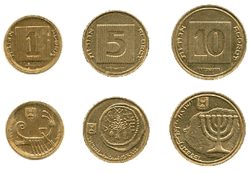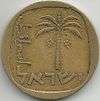Israeli agora

The agora (Hebrew: אגורה, pl. אגורות, agorot) is a denomination of the currency of Israel. The Israeli currency – the new Israeli shekel (NIS) – is divided into 100 agorot.
History
The name agora actually refers to three kinds of currencies that were used in Israel throughout its history, all of them have been subdivisions of the main currency units.
This name was used for the first time in 1960, when the Israeli government decided to change the subdivision of the Israeli lira (a.k.a. Israeli pound) from 1000 prutot to 100 agorot.[1] The name was suggested by the Academy of the Hebrew Language, and was borrowed from the Hebrew Bible, I Samuel 2:36 ...every one that is left in thine house shall come and crouch to him for a piece of silver... (the term "piece of silver" appears in Hebrew as "agorat kessef").
In 1980 the Israeli lira was abolished and replaced by the shekel at a rate of 10 IP per 1 shekel. The new subdivision of the shekel was named agora ħadasha ("new agora"). There were 100 new agorot in 1 shekel. The high rate of inflation in Israel in the early 1980s forced the Israeli government to change the Israeli currency once again in 1985. The new shekel was introduced at a rate of 1000 S per 1 NS. The name agora was used once again for its subdivision. This time the term "new" was avoided, in order to prevent confusion with the older subdivision (the pre-1980 agora was long since out of circulation). Currently, the term agora refers to the 100th part of the new shekel. There are coins of 10 and 50 agorot, though the 50 agorot coin bears the inscription: "½ New Shekel".
A coin of 1 agora was in use until April 1, 1991[2] and a coin of 5 agorot was in use until January 1, 2008 when the Bank of Israel decided to cease production. This was due to the costs spent on its production which considerably exceeded the coin's value. Today, when paying in cash, the price must be rounded to the nearest multiple of 10 agorot. When buying several items, the rounding is done for the total sum. There is no rounding when paying with cheques, credit cards or bank orders.
Early lira agora
| Image | Face Value | Diameter | Composition | Description | ||
|---|---|---|---|---|---|---|
| Obverse | Reverse | Obverse | Reverse | |||
 |
 |
1 agora | 20 mm | Aluminum | 1 agora from Hebrew year 5722 (Sept. 1961 to Sept. 1962), | wheat labeled “Israel” in Arabic (left) and Hebrew (bottom) |
 |
 |
10 agorot | 21.3 mm | Bronze | 10 agorot from Hebrew year 5721 (Sept. 1960 to Sept. 1961) | date palm labeled “Israel” in Arabic (left) and Hebrew (bottom) |